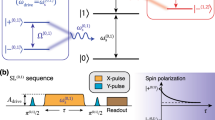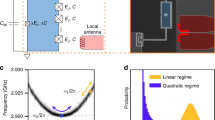Abstract
Quantum coherence in natural and artificial spin systems is fundamental to applications ranging from quantum information science to magnetic-resonance imaging and identification. Several multipulse control sequences targeting generalized noise models have been developed to extend coherence by dynamically decoupling a spin system from its noisy environment. In any particular implementation, however, the efficacy of these methods is sensitive to the specific frequency distribution of the noise, suggesting that these same pulse sequences could also be used to probe the noise spectrum directly. Here we demonstrate noise spectroscopy by means of dynamical decoupling using a superconducting qubit with energy-relaxation time T1=12 μs. We first demonstrate that dynamical decoupling improves the coherence time T2 in this system up to the T2=2 T1 limit (pure dephasing times exceeding 100 μs), and then leverage its filtering properties to probe the environmental noise over a frequency (f) range 0.2–20 MHz, observing a 1/fα distribution with α<1. The characterization of environmental noise has broad utility for spin-resonance applications, enabling the design of optimized coherent-control methods, promoting device and materials engineering, and generally improving coherence.
This is a preview of subscription content, access via your institution
Access options
Subscribe to this journal
Receive 12 print issues and online access
$209.00 per year
only $17.42 per issue
Buy this article
- Purchase on Springer Link
- Instant access to full article PDF
Prices may be subject to local taxes which are calculated during checkout





Similar content being viewed by others
References
Hahn, E. L. Spin echoes. Phys. Rev. 80, 580–594 (1950).
Carr, H. Y. & Purcell, E. M. Effects of diffusion on free precession in nuclear magnetic resonance experiments. Phys. Rev. 94, 630–638 (1954).
Meiboom, S. & Gill, D. Modified spin-echo method for measuring nuclear relaxation times. Rev. Sci. Instrum. 29, 688–691 (1958).
Slichter, C. P. Principles of Nuclear Magnetic Resonance 3rd edn (Springer, 1990).
Biercuk, M. J. et al. Optimized dynamical decoupling in a model quantum memory. Nature 458, 996–1000 (2009).
Biercuk, M. J. et al. Experimental Uhrig dynamical decoupling using trapped ions. Phys. Rev. A 79, 062324 (2009).
Sagi, Y., Almog, I. & Davidson, N. Process tomography of dynamical decoupling in a dense cold atomic ensemble. Phys. Rev. Lett. 105, 053201 (2010).
Szwer, D. J., Webster, S. C., Steane, A. M. & Lucas, D. M. Keeping a single qubit alive by experimental dynamic decoupling. J. Phys. B 44, 025501 (2011).
Du, J. et al. Preserving electron spin coherence in solids by optimal dynamical decoupling. Nature 461, 1265–1268 (2009).
Barthel, C., Medford, J., Marcus, C. M., Hanson, M. P. & Gossard, A. C. Interlaced dynamical decoupling and coherent operation of a singlet–triplet qubit. Phys. Rev. Lett. 105, 266808 (2010).
Bluhm, H. et al. Dephasing time of GaAs electron-spin qubits coupled to a nuclear bath exceeding 200 μs. Nature Phys. 7, 109–113 (2011).
de Lange, G., Wang, Z. H., Riste, D., Dobrovitski, V. V. & Hanson, R. Universal dynamical decoupling of a single solid-state spin from a spin bath. Science 330, 60–63 (2010).
Ryan, C. A., Hodges, J. S. & Cory, D. G. Robust decoupling techniques to extend quantum coherence in diamond. Phys. Rev. Lett. 105, 200402 (2010).
Viola, L. & Lloyd, S. Dynamical suppression of decoherence in two-state quantum systems. Phys. Rev. A 58, 2733–2744 (1998).
Faoro, L. & Viola, L. Dynamical suppression of 1/f noise processes in qubit systems. Phys. Rev. Lett. 92, 117905 (2004).
Falci, G., D’Arrigo, A., Mastellone, A. & Paladino, E. Dynamical suppression of telegraph and 1/f noise due to quantum bistable fluctuators. Phys. Rev. A 70, 040101 (2004).
Uhrig, G. S. Keeping a quantum bit alive by optimized π -pulse sequences. Phys. Rev. Lett. 98, 100504 (2007).
Uhrig, G. S. Exact results on dynamical decoupling by π pulses in quantum information processes. New J. Phys. 10, 083024 (2008).
Cywiński, L., Lutchyn, R. M., Nave, C. P. & Das Sarma, S. How to enhance dephasing time in superconducting qubits. Phys. Rev. B 77, 174509 (2008).
Pasini, S. & Uhrig, G. S. Optimized dynamical decoupling for power-law noise spectra. Phys. Rev. A 81, 012309 (2010).
Clarke, J. & Wilhelm, F. K. Superconducting quantum bits. Nature 453, 1031–1042 (2008).
Lasic, S., Stepisnik, J. & Mohoric, A. Displacement power spectrum measurement by CPMG in constant gradient. J. Magn. Reson. 182, 208–214 (2006).
Jenista, E. R., Stokes, A. M., Branca, R. T. & Warren, W. S. Optimized, unequal pulse spacing in multiple echo sequences improves refocusing in magnetic resonance. J. Chem. Phys. 131, 204510 (2009).
Orlando, T. et al. Superconducting persistent-current qubit. Phys. Rev. B 60, 15398–15413 (1999).
Mooij, J. E. et al. Josephson persistent-current qubit. Science 285, 1036–1039 (1999).
Astafiev, O., Pashkin, Y. A., Nakamura, Y., Yamamoto, T. & Tsai, J. S. Quantum noise in the Josephson charge qubit. Phys. Rev. Lett. 93, 267007 (2004).
Averin, D. V. Quantum computing and quantum measurement with mesoscopic Josephson junctions. Fortschr. Phys. 48, 1055–1074 (2000).
Makhlin, Y., Schön, G. & Shnirman, A. Quantum-state engineering with Josephson-junction devices. Rev. Mod. Phys. 73, 357–400 (2001).
Ithier, G. et al. Decoherence in a superconducting quantum bit circuit. Phys. Rev. B 72, 134519 (2005).
Clerk, A. A., Devoret, M. H., Girvin, S. M., Marquardt, F. & Schoelkopf, R. J. Introduction to quantum noise, measurement, and amplification. Rev. Mod. Phys. 82, 1155–1208 (2010).
Yoshihara, F., Harrabi, K., Niskanen, A. O., Nakamura, Y. & Tsai, J. S. Decoherence of flux qubits due to 1/f flux noise. Phys. Rev. Lett. 97, 167001 (2006).
Martinis, J. M., Nam, S., Aumentado, J., Lang, K. M. & Urbina, C. Decoherence of a superconducting qubit due to bias noise. Phys. Rev. B 67, 094510 (2003).
Borneman, T. W., Hurlimann, M. D. & Cory, D. G. Application of optimal control to CPMG refocusing pulse design. J. Magn. Reson. 207, 220–233 (2010).
Wellstood, F. C., Urbina, C. & Clarke, J. Low-frequency noise in dc superconducting quantum interference devices below 1 K. Appl. Phys. Lett. 50, 772–774 (1987).
Geva, E., Kosloff, R. & Skinner, J. L. On the relaxation of a two-level system driven by a strong electromagnetic field. J. Chem. Phys. 102, 8541–8561 (1995).
Van der Wal, C. H., Wilhelm, F. K., Harmans, C. J. P. M. & Mooij, J. E. Engineering decoherence in Josephson persistent-current qubits. Eur. Phys. J. B 31, 111–123 (2003).
Shnirman, A., Schön, G., Martin, I. & Makhlin, Y. Low- and high-frequency noise from coherent two-level systems. Phys. Rev. Lett. 94, 127002 (2005).
Kerman, A. J. & Oliver, W. D. High-fidelity quantum operations on superconducting qubits in the presence of noise. Phys. Rev. Lett. 101, 070501 (2008).
Van Harlingen, D. J. et al. Decoherence in Josephson-junction qubits due to critical-current fluctuations. Phys. Rev. B 70, 064517 (2004).
Acknowledgements
We gratefully acknowledge T. Orlando for support in all aspects of this work. We appreciate M. Biercuk, J. Clarke, L. Levitov and S. Lloyd for discussions, and P. Forn-Diaz and S. Valenzuela for comments on the manuscript. We thank P. Murphy and the LTSE team at MIT Lincoln Laboratory for technical assistance. This work was sponsored by the US Government, the Laboratory for Physical Sciences, the National Science Foundation and the Funding Program for World-Leading Innovative R&D on Science and Technology (FIRST), CREST-JST, MEXT kakenhi ‘Quantum Cybernetics’. Opinions, interpretations, conclusions and recommendations are those of the author(s) and are not necessarily endorsed by the US Government.
Author information
Authors and Affiliations
Contributions
F. Yoshihara, K.H., Y.N. and J-S.T. designed and fabricated the device. J.B. and S.G. carried out the experiments. G.F., S.G. and J.B. contributed to the software infrastructure. J.B., F. Yan, W.D.O. and Y.N. analysed the data and F. Yoshihara and D.G.C. provided feedback. J.B. and W.D.O. wrote the paper with feedback from all authors. W.D.O. supervised the project. All authors contributed to discussions during the conception, execution and interpretation of the experiments.
Corresponding author
Ethics declarations
Competing interests
The authors declare no competing financial interests.
Supplementary information
Supplementary Information
Supplementary Information (PDF 909 kb)
Rights and permissions
About this article
Cite this article
Bylander, J., Gustavsson, S., Yan, F. et al. Noise spectroscopy through dynamical decoupling with a superconducting flux qubit. Nature Phys 7, 565–570 (2011). https://doi.org/10.1038/nphys1994
Received:
Accepted:
Published:
Issue Date:
DOI: https://doi.org/10.1038/nphys1994
This article is cited by
-
Optimizing quantum gates towards the scale of logical qubits
Nature Communications (2024)
-
Hamiltonian phase error in resonantly driven CNOT gate above the fault-tolerant threshold
npj Quantum Information (2024)
-
Direct manipulation of a superconducting spin qubit strongly coupled to a transmon qubit
Nature Physics (2023)
-
Robust adiabatic composite pulses for quantum population inversion
Quantum Information Processing (2023)
-
Noisy intermediate-scale quantum computers
Frontiers of Physics (2023)



